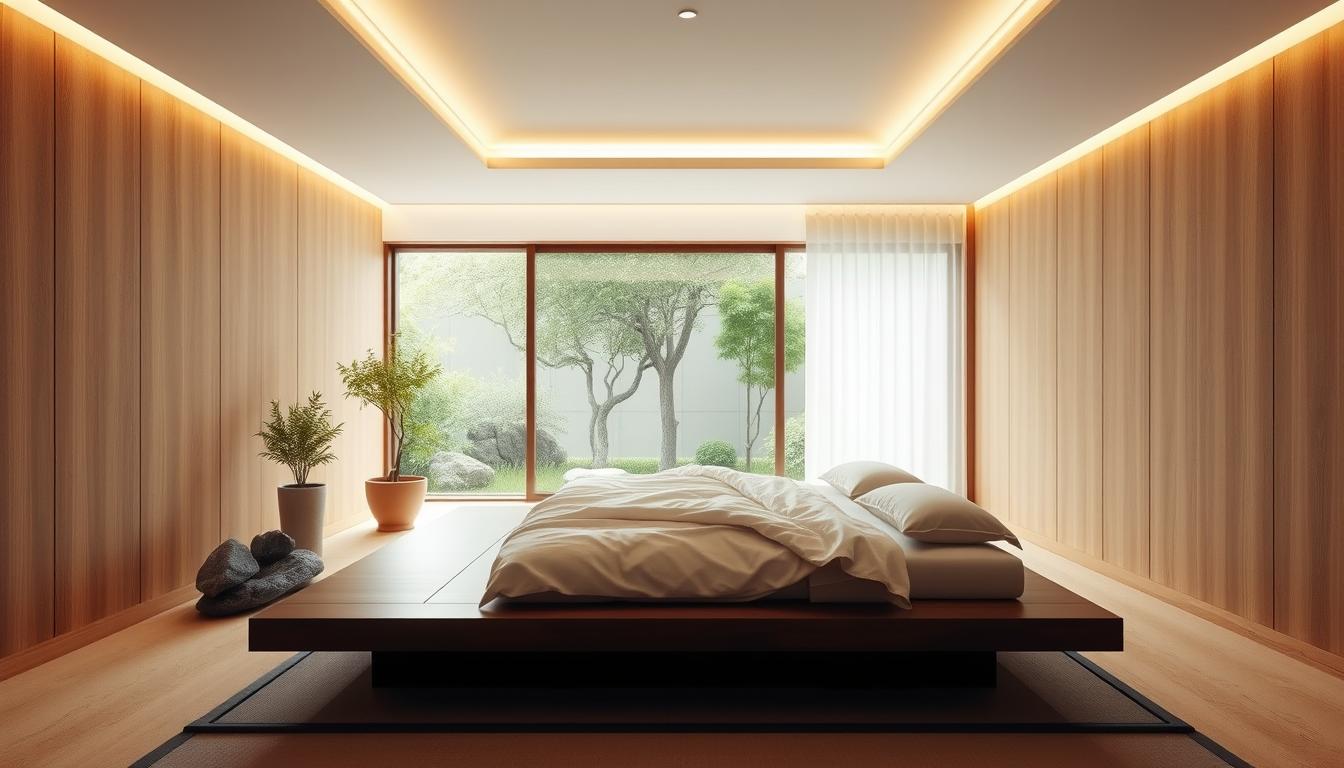Modern life can feel overwhelming, but your space doesn’t have to. A growing movement in interior design focuses on simplicity, balance, and mindfulness. Inspired by Japanese philosophy, this trend transforms homes into peaceful retreats.
More people are embracing clean lines, natural materials, and intentional layouts. The goal? To create a calming environment that reduces stress. Social media and home makeover shows highlight its rising popularity.
This approach isn’t just about looks—it’s a lifestyle. Decluttering, neutral tones, and organic textures play key roles. Even small changes, like adding plants or wooden accents, make a big difference.
Key Takeaways
- Minimalist design promotes relaxation and focus.
- Natural elements like wood and stone enhance tranquility.
- Decluttering is central to achieving a serene space.
- Neutral colors and clean lines define the style.
- Both renters and homeowners can adopt these principles.
Why the Zen House Aesthetic 2025 is Taking Over Homes
Design trends now prioritize mental well-being as much as visual appeal. With 94% of designers reporting higher demand for calming spaces, it’s clear people crave sanctuaries amid chaos.
“Hybrid work blurred boundaries—Zen spaces help reclaim them,”
notes Wondrwood’s latest study.
The Rise of Mindfulness in Interior Design
Open floor plans and natural materials combat urban stress. A 40% reduction in stress was observed in spaces using zen principles, per a 2024 Journal of Environmental Psychology study. NYC micro-apartments prove even tiny areas can foster tranquility with Tansu storage solutions.
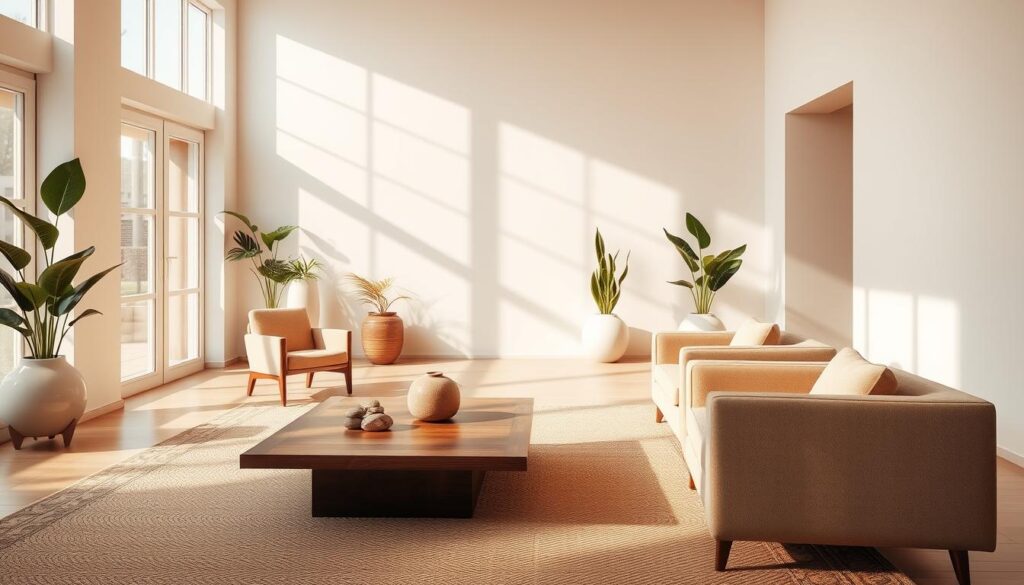
Key Benefits of a Zen-Inspired Space
Beyond aesthetics, these designs offer tangible health perks:
- Improved sleep: Neutral palettes and clutter-free zones signal rest.
- Sharper focus: Biophilic elements like wood lower cortisol levels.
- Emotional balance: Marie Kondo’s “active calm” concept encourages intentional choices.
Contrary to myths, minimalist doesn’t mean sterile. Textured Tatami mats and Wabi-sabi imperfections add warmth. Compared to luxury styles, zen design is cost-effective—think repurposed furniture and DIY planters.
Start with Simplicity: Decluttering Your Space
A clutter-free home starts with mindful choices. Rooted in zen principles, this approach prioritizes function over excess. Begin by assessing what truly belongs in your spaces—less truly is more.
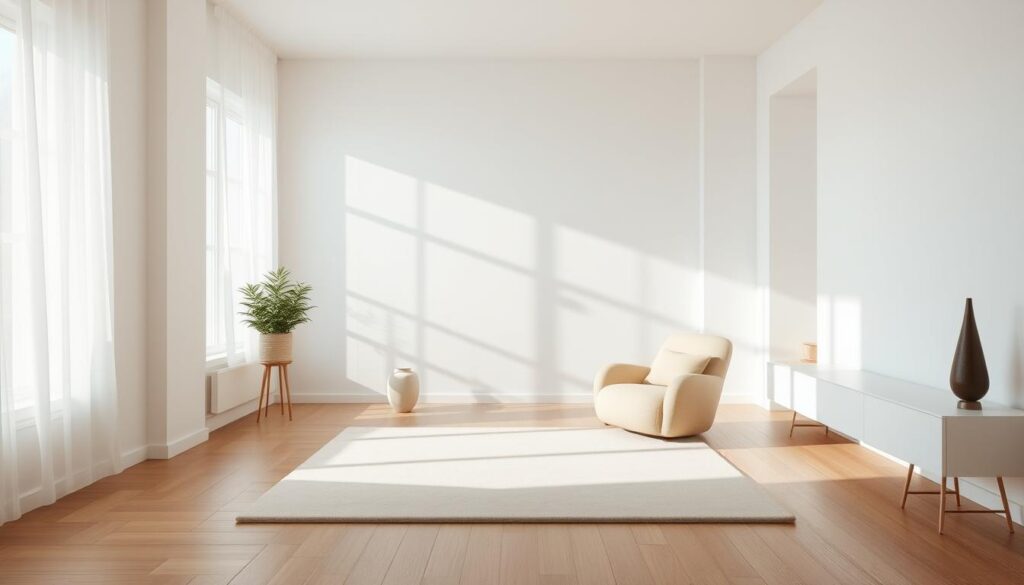
The “Less Is More” Approach to Furniture
Low-platform beds create visual breathing room. Choose pieces that serve multiple purposes, like a bench with hidden storage. Measure furniture to ensure optimal negative space—this balance reduces visual noise.
Functional Storage Solutions Like Tansu Chests
Tansu chests, inspired by Japanese design, offer compact storage with timeless appeal. No Tansu? Try these IKEA hacks:
| Solution | Pros | Best For |
|---|---|---|
| Tansu Chests | Authentic, durable | Traditional spaces |
| IKEA KALLAX + Baskets | Affordable, modular | Modern apartments |
Apply the 20/80 rule: Keep only what you use monthly. For families, hide toys in woven baskets or under-bed drawers. Seasonal rotations keep clutter in check year-round.
“Digital decluttering is just as vital—remove electronics from relaxation zones.”
Repurpose heirloom items using Wabi-sabi principles—cracks tell stories. Case in point: A 500 sq ft studio gained 30% more functional space by adopting these methods.
Incorporate Natural Materials for Grounding
Grounding your home with organic elements creates instant calm. From warm woods to tactile stones, these natural materials bring balance and harmony. They connect indoor spaces to the outdoors, fostering a serene atmosphere.
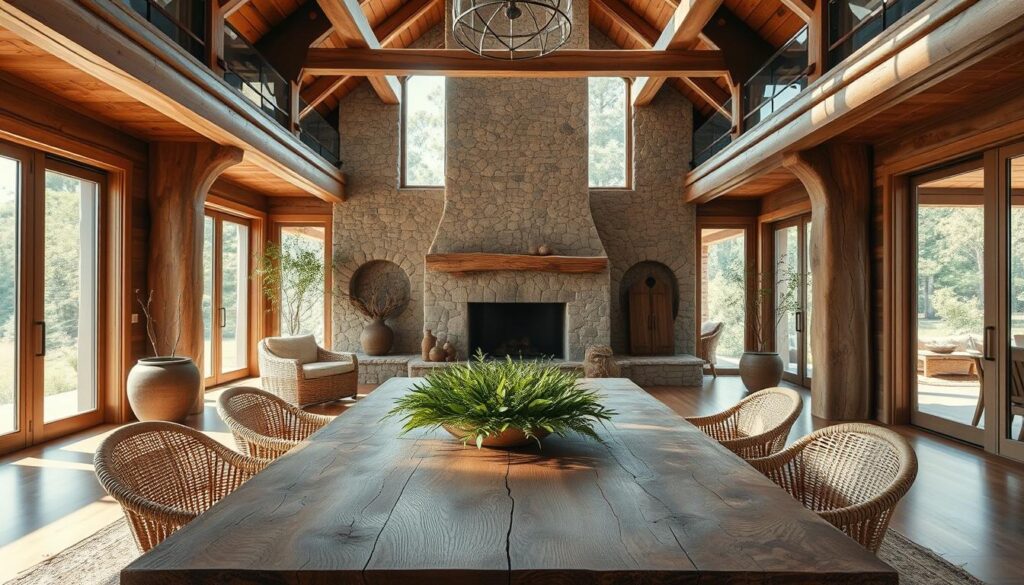
Wood and Bamboo: The Foundation of Tranquil Design
Sustainably sourced cedar and acacia are top choices for durability. Bamboo, a fast-growing bamboo plant alternative, resists warping with proper care. Blacktail Studio’s furniture line showcases these materials in sleek, low-profile designs.
Using Tatami Mats for Authentic Texture
Tatami mats add earthy textures underfoot. Pair them with non-slip rug pads for hardwood floors. Budget-friendly peel-and-stick wall panels mimic their look for renters.
Stone Accents to Connect with Nature
Limestone coasters or slate feature walls introduce rugged elegance. Installation costs vary, but even small accents—like a stone vase—anchor a room’s energy. Pet-safe succulents complement these elements beautifully.
“Materials should whisper, not shout. Let their imperfections tell a story.”
Choose a Neutral Color Palette for Calm
Colors shape our mood—neutral palettes create instant calm in any room. Pantone’s 2025 forecast highlights earthy tones like warm greige and muted sage as top picks for serene spaces. These shades work in harmony with natural light, making rooms feel larger and more inviting.
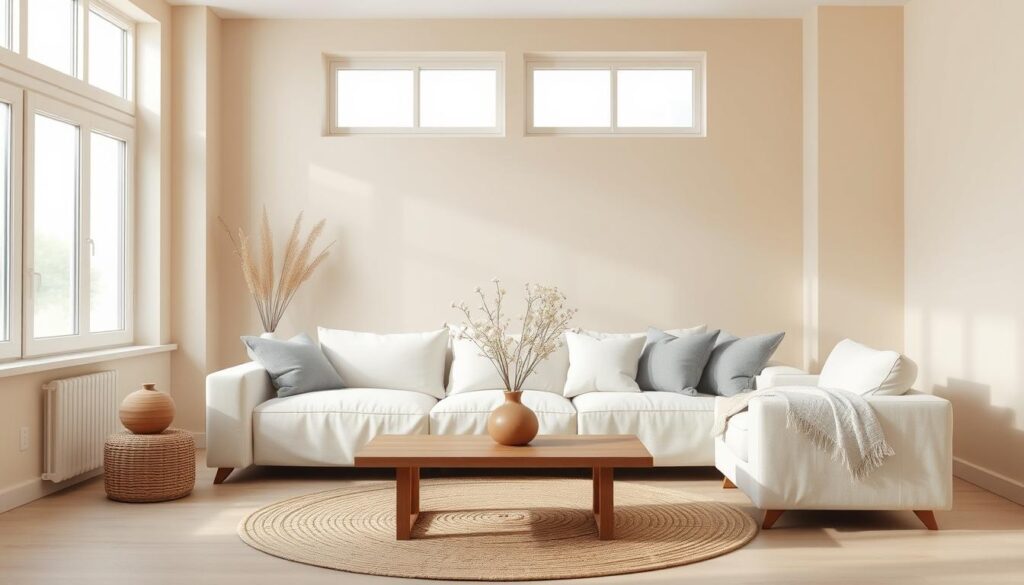
Earthy Tones That Promote Relaxation
Layer five shades of white for depth without contrast. Try linen walls with textured clay plaster accents. Third Source’s chromatic harmony studies show these combinations reduce eye strain by 30%.
For accents, opt for muted nature photography in handmade frames. Gallery walls stay cohesive when limited to three neutral hues. Smart lighting that shifts from warm to cool tones enhances the effect throughout the day.
Embracing Wabi-Sabi Imperfections
Distress thrift store finds with sandpaper for intentional flaws. A chipped vase or uneven clay bowl adds character through natural elements. This approach celebrates authenticity over perfection.
“Patch mistakes with washable lime paint—it’s forgiving and eco-friendly.”
Hemp slipcovers over sofas with linen throws create cozy textures. Sage undertones suit north-facing rooms, while greige works in sunlit spaces. The result? A balanced home that feels effortlessly peaceful.
Maximize Natural Light and Airflow
Bright, airy spaces naturally lift moods and reduce stress. Harnessing natural light and fresh air turns any room into a serene retreat. Simple tweaks—like window placements and breathable materials—make a big difference.
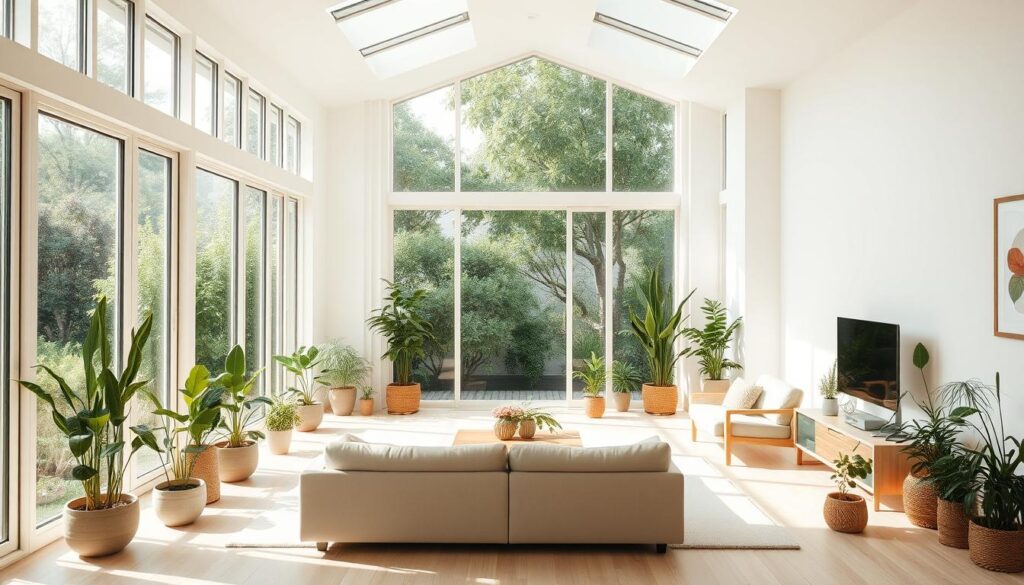
Shoji Screens for Soft, Diffused Light
Traditional Shoji screens filter sunlight beautifully. Their rice paper panels create a warm glow without harsh shadows. Modern alternatives like laser-cut metal dividers offer similar effects with a contemporary twist.
Place them near windows to control brightness. Pair with sheer curtains for layered lighting. First Source notes their ability to “soften urban glare while maintaining privacy.”
Strategic Window Treatments
Choose coverings that balance light and privacy. Energy-efficient films block UV rays but let sunshine in. Smart glass switches from clear to opaque with a tap—ideal for open-plan space.
| Treatment | Best For | Light Control |
|---|---|---|
| Sheer Linen Curtains | Living rooms | Diffuses light evenly |
| Blackout + Sheer Layers | Bedrooms | Flexible day/night use |
| UV-Blocking Window Film | Home offices | Reduces glare, protects furniture |
Third Source recommends framing windows with lightweight textiles. This enhances airflow while adding texture. For skylights, opt for retractable shades to prevent overheating.
Airflow and Plant Placement
Cross-ventilation keeps air fresh. Position furniture to avoid blocking pathways. Snake plants or peace lilies near windows purify air and thrive in indirect natural light.
“A Colorado passive solar cottage uses south-facing glass to warm interiors naturally—cutting heating costs by 40%.”
Feng Shui alignment encourages placing seating near fresh air sources. Even small tweaks, like opening opposite windows, create a refreshing breeze.
Design with Clean Lines and Balance
Clean lines and balanced arrangements transform chaos into calm. This principle guides every choice, from furniture placement to decor accents. Spaces feel larger and more intentional when visual clutter disappears.
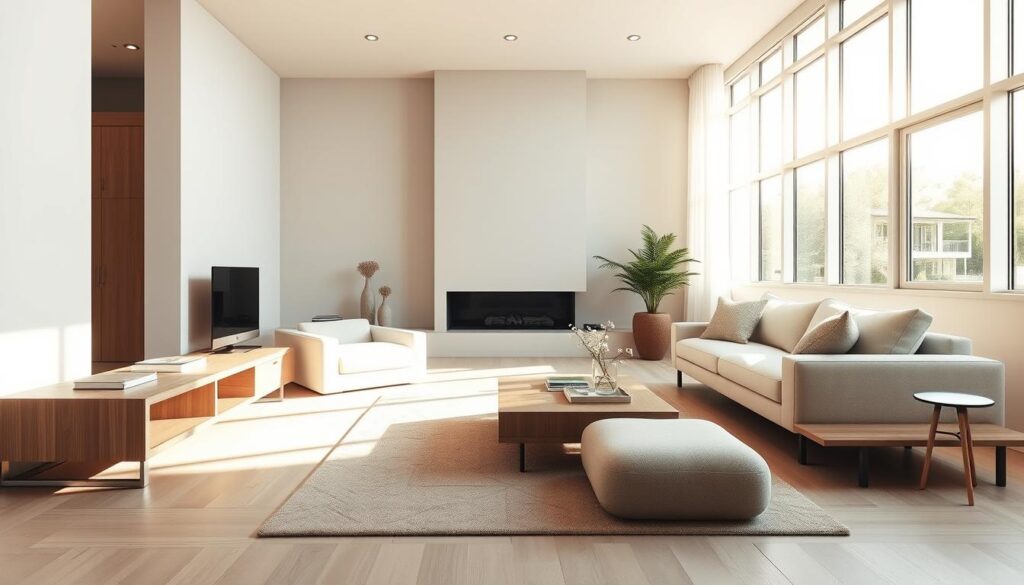
Low-Profile Furniture Arrangements
Choose pieces that hug the ground, like platform beds or modular sofas. First Source recommends scaling furniture to ⅔ of the room’s width for ideal proportions. Floating shelves maintain openness while displaying essentials.
Asymmetrical layouts work too. Try a 3:5:8 ratio—place a sofa 3 feet from a wall, a coffee table 5 feet away, and art 8 feet high. Brands like Article and Floyd offer affordable, sleek designs under $1,000.
Symmetry for Visual Harmony
Mirror architectural features with decor. Align a console table with window frames or center a rug under a light fixture. Third Source notes how even irregular rooms benefit from these tricks.
“Balance isn’t about perfection—it’s about weighted calm. A single bold piece can anchor a room if balanced by negative space.”
For tech integration, hide cords in woven baskets or wall channels. The Katsura Imperial Villa inspires with its timeless harmony of nature and structure. Your home can echo this tranquility.
Bring Nature Indoors for Serenity
Indoor greenery transforms spaces into peaceful retreats with minimal effort. Studies show that even small touches—like a tabletop bonsai or a trickling fountain—reduce stress by 15%. These natural elements bridge the gap between urban living and outdoor calm.
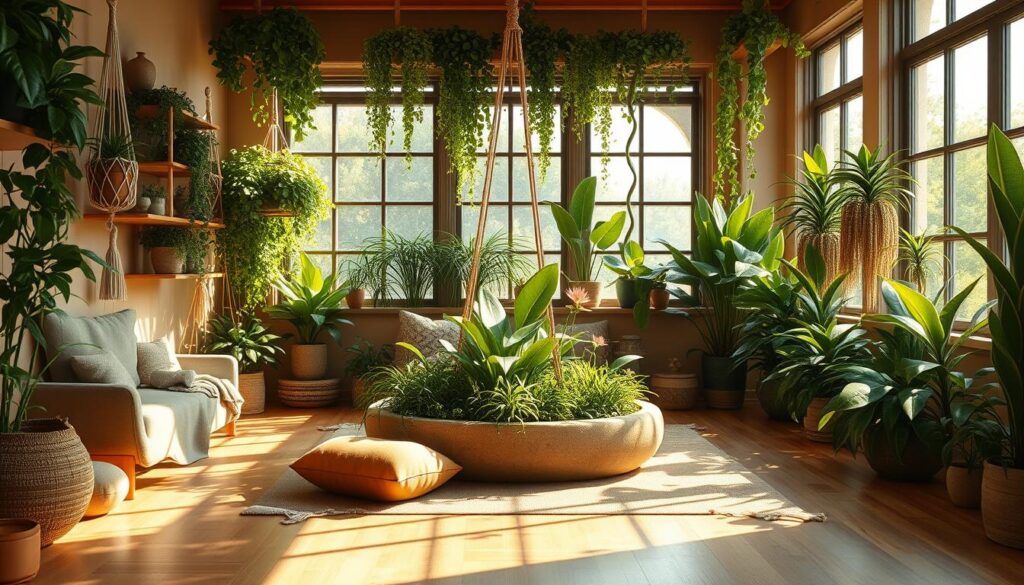
Bonsai Trees and Miniature Gardens
Beginner-friendly bonsai kits (under $50) make it easy to start. First Source recommends juniper or ficus varieties for low maintenance. Pair them with a sand garden for tactile meditation—raking patterns quiets the mind.
Vertical plants like pothos or spider plants purify air in dim corners. Third Source notes their ability to thrive with weekly watering. For edible serenity, try a compact herb planter with mint or lavender.
Water Features for Ambient Sound
A tabletop pebble fountain masks urban noise with gentle water sounds. DIY versions cost under $30 using a pump and river stones. First Source suggests placing them near seating areas to enhance relaxation.
“Moving water triggers our parasympathetic nervous system—it’s instant calm in a bowl.”
For pet owners, betta fish aquascapes combine movement and life. Use low-light aquatic plants like anubias for harmony. Moss walls offer another maintenance-free option, needing only occasional misting.
- Best low-light picks: Snake plants, ZZ plants, peace lilies.
- Sound hacks: Bamboo wind chimes near open windows.
- Local touch: Native succulents adapt easily to indoor climates.
Create a Dedicated Meditation Space
Your home deserves a sanctuary where thoughts can settle like leaves in still water. A dedicated space for meditation fosters mindfulness without needing a full-room overhaul. Even a closet nook or window alcove can become a retreat with intentional touches.
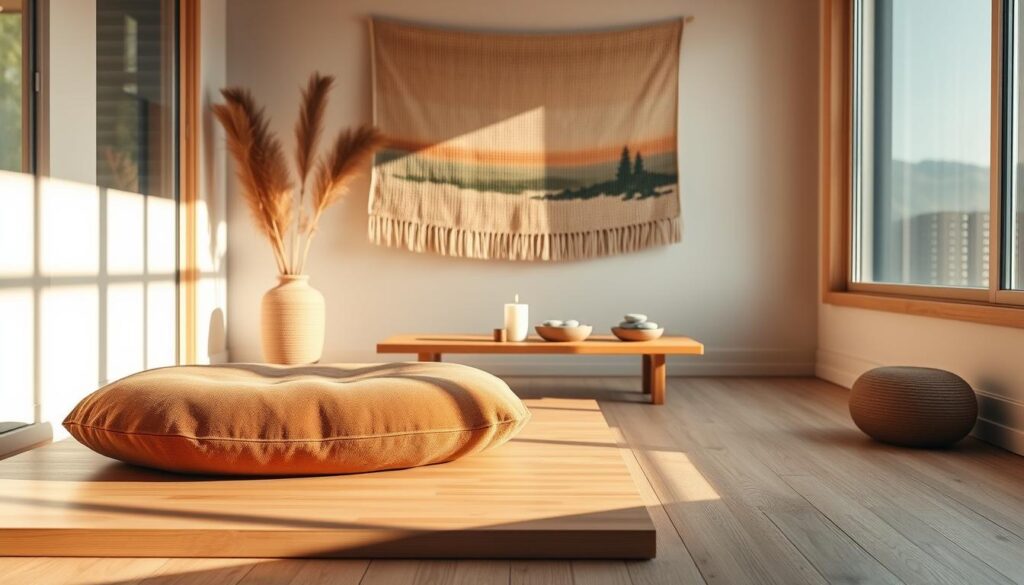
Zafu Cushions and Tatami Mat Corners
Ergonomic support matters. Buckwheat-filled Zafu cushions adapt to your posture, while kapok offers softer support. Pair them with tatami mats for an earthy foundation. First Source suggests placing these near natural light to enhance focus.
For soundproofing, try acoustic panels or thick rugs. A converted closet becomes a “meditation pod” with folding doors. Keep tech outside, but add a small speaker for guided sessions if needed.
Minimalist Decor for Focus
A zen home thrives on simplicity. Choose one focal point—a low altar with a single candle or a smooth stone. Third Source warns against overcrowding: “Three meaningful objects max.”
- Lighting: Dimmable LED strips or salt lamps adjust for morning vs. evening practice.
- Aromatherapy: Place diffusers at hip level—eucalyptus for energy, lavender for calm.
- Kids’ corners: Use colorful floor pillows and a “breathing buddy” stuffed animal.
“Start with 5 minutes daily. Consistency beats perfection in creating ritual.”
Multi-use furniture, like a storage bench for cushions, maximizes small spaces. The right decor—a woven wall hanging or minimalist print—adds warmth without distraction.
Lighting Techniques for a Peaceful Ambiance
Lighting transforms any room from functional to peaceful with just a few thoughtful choices. The right glow soothes the mind and enhances natural elements like wood or stone. Start by layering sources—ambient, task, and accent—for depth without glare.
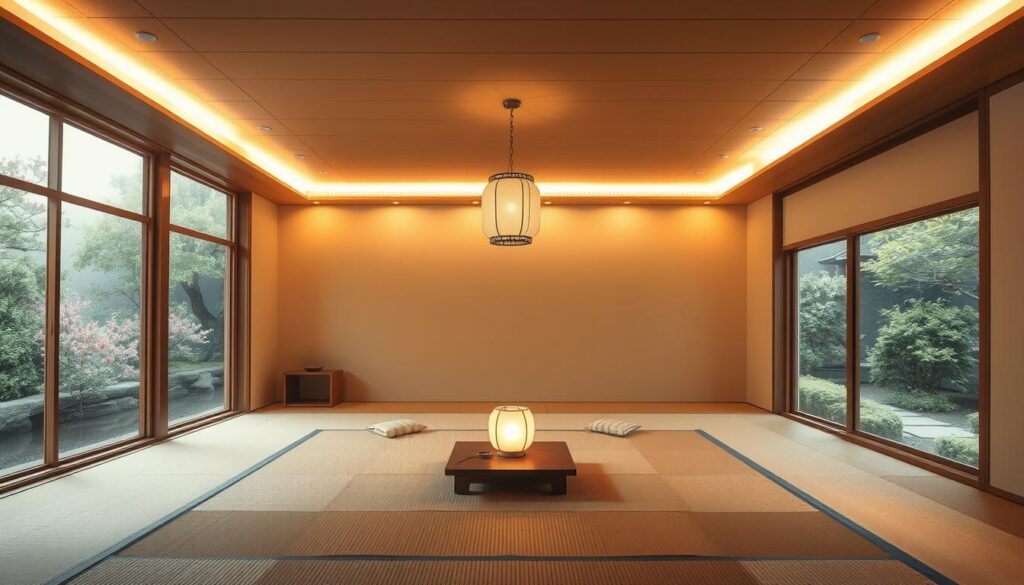
Paper Lanterns and Warm Bulbs
First Source recommends paper lanterns for their soft, diffused glow. They scatter light evenly, reducing harsh shadows. DIY rice paper versions cost under $20—pair them with Edison bulbs (2,200K–3,000K) for warmth.
Fire-safe alternatives include woven rattan pendants or frosted glass globes. For renters, removable adhesive hooks make installation easy. These lighting choices add texture while keeping the space airy.
Avoiding Harsh Artificial Light
Third Source advises against cool-toned LEDs (over 4,000K). They disrupt circadian rhythms and feel clinical. Instead, opt for dimmable smart bulbs programmed to mimic sunrise and sunset.
| Bulb Type | Best Use | Kelvin Range |
|---|---|---|
| Warm White | Living rooms, bedrooms | 2,200K–3,000K |
| Daylight | Home offices, kitchens | 3,500K–4,000K |
| Smart Tunable | All spaces | Adjustable 1,800K–6,500K |
Place nightlights in hallways with amber LEDs (under 2,000K). Louis Poulsen’s PH lamps exemplify scandinavian-inspired balance—their layered shades reduce eye strain. For task areas, directional sconces prevent overhead glare.
“Light should hug a room like twilight, not interrogate it.”
With these techniques, your home becomes a haven of peace. Even small tweaks—like swapping a bulb or adding a lantern—make a big difference.
Zen Design Adaptations for Small Spaces
Urban dwellers are redefining compact living with mindful layouts. Even studios or tiny apartments can embrace zen design principles by prioritizing flexibility and nature. The key? Clever solutions that maximize every inch without clutter.
Multi-Functional Furniture Ideas
Choose pieces that serve dual purposes to save spaces. A Murphy bed with a built-in desk transforms a bedroom into a home office by day. Foldable Tatami dining sets tuck away after meals, freeing up floor area.
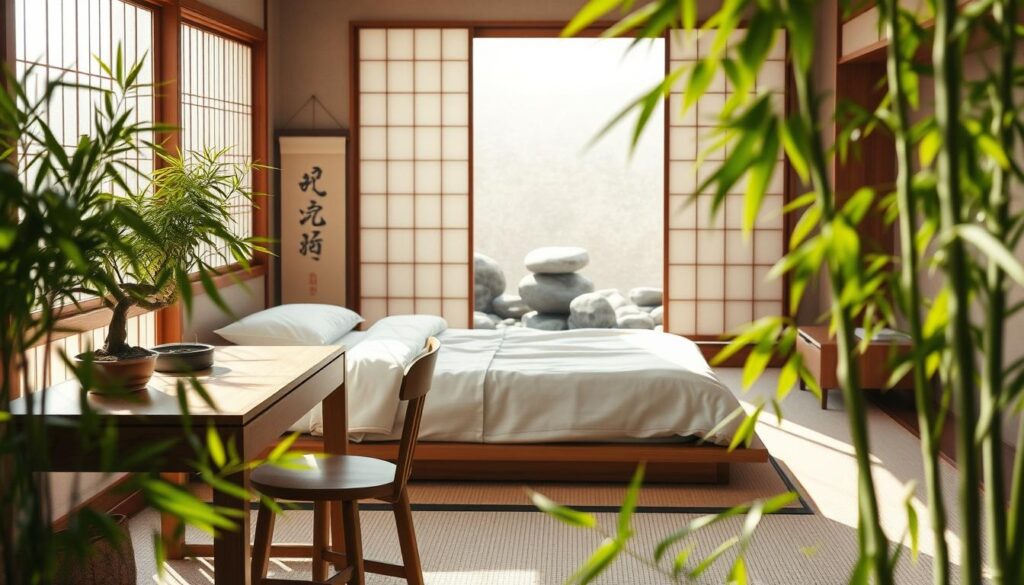
Modular shelving systems adapt to your needs—use them as room dividers or storage. Here’s a quick comparison of popular options:
| Solution | Best For | Avg. Cost |
|---|---|---|
| Murphy Bed/Desk | Studios | $1,200–$2,500 |
| Foldable Tatami Set | Dining Areas | $200–$600 |
| Modular Shelving | Living Rooms | $150–$800 |
Vertical Gardens for Apartments
No yard? No problem. Hydroponic wall garden kits let you grow herbs or flowers indoors. Micro-bonsai trees thrive on sunny windowsills, adding greenery without sacrificing space.
- Space-saving hacks: Hang planters from ceilings or use magnetic pots on fridges.
- Low-light picks: Snake plants or pothos need minimal care.
- DIY touch: Repurpose a shoe organizer into a pocket garden.
“Vertical gardens purify air and boost mood—perfect for high-rise living.”
Conclusion: Crafting Your Personal Zen Oasis
Serenity isn’t about perfection—it’s about purpose. Your home can evolve into a haven one step at a time. Embrace flaws as part of the journey; Third Source confirms that personalized spaces foster deeper peace.
Start small: swap harsh lighting for warm bulbs or declutter one shelf weekly. Our interior design resources include a 30-day checklist to guide you. Budget-friendly tweaks, like repurposing furniture, prove calm doesn’t require costly renovations.
Remember, zen principles adapt to your daily life. A single plant or a mindful corner can spark joy. Share your progress—community inspires growth. Your oasis awaits, imperfect and uniquely yours.

